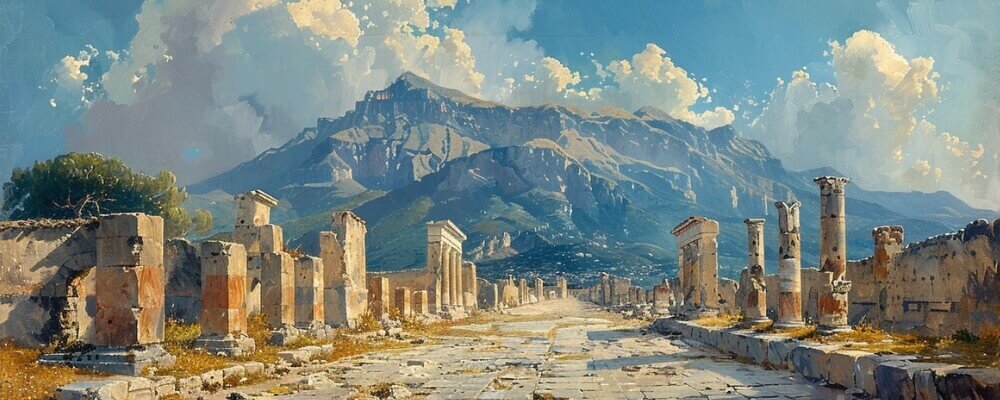Why travel to Pompeii? This renowned site provides a unique glimpse into the old world. Nestled in the shadow of Mount Vesuvius, its remains stand as a witness to Roman civilization’s magnificence and the unexpected tragedy that brought it to an end in 79 AD. Visitors to Pompeii may stroll the same cobblestone streets that were once busy with Roman life, visit preserved houses and public spaces, and see vivid paintings that show the creativity of the past. It is a site where history is palpable, allowing us to gain a better understanding of old ways of existence and great natural forces.
Introduction to Pompeii
Travel to Pompeii immerses you in the echoes of an old Roman city that was once bustling with activity. Today, it serves as a poignant archeological site in Naples, Italy, where history buffs may discover a world buried in volcanic ash since 79 AD. This introduction to Pompeii is more than simply seeing the ruins; it’s also about observing the daily lives of its inhabitants—from the remains of bakeries and baths to amphitheaters and residences with still-vibrant frescos. Pompeii is a unique image of antiquity preserved in time, allowing visitors to go back over two thousand years.
Brief history of Pompeii
Travel to Pompeii and you’ll uncover a rich tapestry of history dating back to the 6th century BC, when the Oscans first occupied the area. Pompeii grew into a bustling city with a complex water system, an amphitheater, and active public markets after falling under Roman power in the first century BC. However, its prosperity was abruptly ended by the cataclysmic eruption of Mount Vesuvius in 79 AD, which buried the city in ash and pumice. Unearthed some 1,700 years later, the site provides a frozen view into ancient life, with intact streets and dwellings that serve as a poignant reminder of its vivid history.
Significance of Pompeii as an archaeological site
Travel to Pompeii provides a remarkable contact with one of the world’s most significant archeological sites. As you travel through this historic Roman city, you’ll be walking on the same stones that citizens used before Mount Vesuvius’ cataclysmic eruption in 79 AD. Pompeii’s preservation is unrivaled; it gives a remarkable view into historical daily life, from frozen moments in families to public areas such as the forum and theaters. This site not only expands our understanding of Roman architecture and urban planning, but it also represents the moving human stories caught during the city’s abrupt end.
Overview of what readers can expect in the article
Travel to Pompeii and ready to journey back in time. This article will take you through the breathtaking remains of one of the world’s most intriguing archeological sites. You’ll learn about Pompeii’s busy streets before being hushed by Mount Vesuvius’ ash and lava. We’ll look at the rich history that has shaped the daily lives of its residents, from majestic homes covered with frescoes to tiny bakeries serving the local population. Expect to learn about the excavation procedures that have revealed so much, as well as practical ideas for making your visit instructive and memorable.
Rediscovering Ancient Life
Travel to Pompeii for the ultimate experience of rediscovering ancient life. This renowned site, formerly a prosperous Roman metropolis, provides a stunning image of history, trapped in time by Mount Vesuvius’ cataclysmic eruption in 79 AD. As you walk through the restored streets and buildings, you’ll come across relics of bakeries, residences, and baths that provide a realistic picture of ordinary Roman life. Each nook of Pompeii conveys a narrative of the past, from beautiful mosaics to heartbreaking plaster casts of the volcano’s victims, making it a deep educational experience that ties us to our history.
Exploration of the ruins of Pompeii
Travel to Pompeii for an unforgettable experience of one of the world’s most fascinating archeological sites. Walking around the ruins, you’ll sense a strong connection to the past, surrounded by the remnants of a city that once prospered under Roman dominion. The streets and dwellings, shops and temples depict a lively ancient life that was disrupted by Mount Vesuvius’ explosion in 79 AD. This website is more than simply a historical tour; it is a trip through the lives of individuals who lived over two millennia ago, offering a detailed look at the art, architecture, and everyday routines of a forgotten civilization.
Insights into daily life of ancient Pompeiians
Travel to Pompeii to get fascinating insights into the daily lives of the ancient Pompeians. This amazing archeological site provides a vivid view into the past, with streets and residences imprinted with echoes of daily Roman life. As you go around the city, you’ll notice exquisite paintings in the villas depicting themes from festivals and mythology, demonstrating the cultural depth of the time. The restored bakeries, baths, and public forums depict a busy civic life, offering a physical link to the people who once lived, worked, and played in this now-defunct city beneath Mount Vesuvius.
Highlights of notable structures and artifacts
Travel to Pompeii and experience the highlights of its noteworthy architecture and relics. The ancient city, buried beneath ash from Mount Vesuvius’ explosion, houses remarkable archeological findings. The Amphitheater, one of the oldest remaining Roman amphitheaters, provides insight into the social and entertainment traditions of the era. Not to be missed is the Villa of the Mysteries, which is known for its magnificent murals depicting ancient ceremonies. Other items, including as elaborate mosaics and common kitchenware discovered in dwellings, give a look into Pompeians’ domestic lives, giving each visit to this ancient site a voyage back in time.
Preserving History: Pompeii Conservation Efforts
Travel to Pompeii and observe the extraordinary conservation efforts that have preserved the city’s rich heritage. These measures are critical to preserving the integrity of this UNESCO World Heritage site, where the past is covered in volcanic ash. Ancient structures and frescoes are protected and restored using techniques ranging from digital mapping and 3D modeling to conventional restoration operations. Efforts are also focused on averting additional environmental and human-caused harm. Through these efforts, Pompeii continues to provide vital insights into ancient Roman life, guaranteeing that future generations can walk its historic streets and learn from its rich cultural heritage.
Discussion on preservation challenges
Travel to Pompeii and witness firsthand the enormous preservation issues that this ancient city faces. Pompeii, which has been exposed to the elements for centuries since its excavation, faces concerns such as weathering, erosion, and seismic activity, all of which endanger its delicate ruins. While the surge of tourists is economically helpful, it also puts the fragile mosaics and buildings at peril. Efforts to conserve Pompeii include rigorous restoration and advanced technology like 3D scanning to document and safeguard the city’s architecture and artwork. These preservation problems underline the continual effort necessary to keep Pompeii as a vital connection to our shared history.
Efforts taken to conserve Pompeii’s ruins
Travel to Pompeii and see the considerable efforts made to preserve its historic remains. Faced with the combined difficulties of environmental deterioration and human impact, conservationists have tried a variety of tactics. These include stabilizing fragile structures, limiting access to the most susceptible regions, and using innovative monitoring and restoration technology. Collaborations with worldwide specialists and organizations have also aided these efforts, ensuring that every fresco, statue, and public structure is conserved to the greatest extent feasible. These diligent efforts assist to preserve Pompeii as a testimony to Roman urban life, for future generations to learn from and appreciate.
Impact of conservation on visitors’ experiences
Travel to Pompeii to witness the significant influence of continuing conservation efforts on visitors’ interactions with this historic monument. These efforts guarantee that the city’s complex elements, like as the famed paintings that border the Villa of the Mysteries and the massive amphitheater, remain bright and undamaged, boosting educational and visual experiences. Conservation not only protects these precious relics, but it also provides for a more immersive experience. As walkways are stabilized and restricted parts are restored, visitors have a better understanding of ancient Roman life, making each visit both a trip back in time and a testimonial to preservation success.
Pompeii: A Window to Ancient Roman Civilization
Travel to Pompeii for a fascinating glimpse into ancient Roman culture. This amazing archaeological site provides an unmatched view into urban life about two millennia ago, before being buried in volcanic ash from Mount Vesuvius in 79 AD. From the huge amphitheater to the elaborate mosaics decorating affluent people’ residences, every part of Pompeii sheds light on the everyday activities, social structures, and architectural achievements of the period. Visiting Pompeii is like strolling through a living museum, with each intact street and structure telling a narrative about ancient Roman life, culture, and tragedy.
Cultural and historical context of Pompeii within the Roman Empire
Travel to Pompeii to learn about its cultural and historical significance within the Roman Empire. This ancient city was once a vibrant commercial engine and sophisticated urban center on the Bay of Naples, supported by commerce and agriculture. The architecture and artifacts discovered amid the ruins reveal a lavish lifestyle with extensive urban planning, including an amphitheater, aqueducts, and temples. Mount Vesuvius’ catastrophic devastation in 79 AD encased Pompeii in time, affording a frozen insight into Roman daily life, from their complicated political and social structures to their private houses and public areas. This city provides a unique, in-depth glimpse into the complexity of Roman life and its untimely conclusion.
Comparison between Pompeii and other ancient Roman cities
Travel to Pompeii is exceptionally preserved, presenting contrasts and similarities to other ancient Roman cities. Unlike Rome’s ongoing settlement that has piled over its ancient past, Pompeii provides an untouched picture from 79 AD, following Mount Vesuvius’ tragic explosion. This preservation sheds more light on Roman urban life, from street layouts to family interiors, than places like as Ostia and Herculaneum, where continuing growth or other volcanic impacts have affected the archeological record. Pompeii’s enormous remains allow tourists to traverse the streets as Roman inhabitants did, giving them a thorough grasp of their community organization, daily routines, and artistic preferences.
Examination of societal aspects revealed through Pompeii’s remains
Travel to Pompeii and conduct an investigation of sociological features revealed by the city’s remnants. This historic site provides a thorough account of Roman social hierarchy and daily life before the explosion of Mount Vesuvius. Pompeii’s well-preserved remains, ranging from stately palaces to tiny stores, demonstrate the economic differences and lives of its inhabitants. Baths and theaters are examples of public structures that reflect a community that values social contact and cultural participation. Furthermore, artifacts and frescoes illustrate everything from fashion to gastronomy, presenting a complete picture of the diversified and dynamic civilization that once thrived in this great city.
Experiencing Pompeii Today
Travel to Pompeii today and immerse yourself in a rich historical experience that connects the past and the present. As you walk through the historic streets, you will see relics of homes, marketplaces, and temples that give a vivid image of Roman life trapped in time. Visitors are guided around the city by modern pathways and signs, which provide insights while also protecting the remains. Experiencing Pompeii now features interactive displays and virtual reality stations that bring its history to life, allowing you to imagine the vibrant city prior to Mount Vesuvius’ cataclysmic eruption in 79 AD. It’s a one-of-a-kind opportunity to interact with history by witnessing how an ancient culture lived, worked, and left a legacy.
Modern amenities and facilities for visitors
Travel to Pompeii and enjoy not just a trip back in time, but also the convenience of modern conveniences and services meant to improve the guest experience. Today, Pompeii has well-maintained walkways that allow visitors to easily navigate the huge ruins. Informative plaques and digital guides in several languages add historical context and enliven the journey. Rest places, sanitary bathrooms, and water and food stations are conveniently placed around the campus. For those eager for a deeper dig, guided excursions are offered, providing expert insights into this ancient city’s rich history. Pompeii’s visitor-friendly characteristics make it accessible and fascinating for visitors of all ages, offering a memorable and instructive experience.
Tips for navigating the archaeological site
Travel to Pompeii and use these ideas to navigate the ancient site effectively and enjoyably. First, wear comfortable shoes because the cobblestone streets might be uneven and wide. Bring a hat and sunscreen, as shade is limited and the sun may be harsh, especially during the summer months. It is recommended to bring water, however there are multiple refill stations throughout. Choose an early morning visit to avoid crowds and the hot heat. Consider downloading or renting an audio guide for a self-guided tour that will enhance your understanding of the site’s history. Finally, consult the map regularly, as the site’s immensity might be difficult to navigate without a planned itinerary.
Suggestions for immersive experiences and activities in Pompeii
Travel to Pompeii for a fully immersive experience that breathes life into antiquity. Participate in a thematic guided tour to fully connect with the site. These excursions cover a variety of topics related to Pompeian life, including as everyday activities and artistic accomplishments. Take part in a virtual reality encounter at the Forum to witness the city bustling with Roman residents, just how it used to be.
Attend a live demonstration of the archaeological techniques being utilized on-site for a more hands-on understanding. This gives visitors a personal understanding of the preservation efforts. Finally, plan your visit to coincide with one of the numerous ongoing cultural events or exhibitions, which will enhance your entire experience of this old city and provide you a greater understanding of its historical background.
Plan your travel to Italy now and discover the Pompeii. Enjoy your travel to Europe.
Why Travel to Pompeii: FAQs
What is the best time of year to visit Pompeii?
The best time to visit Pompeii is during the spring (April to June) and autumn (September to October) months when the weather is mild and there are fewer crowds. Summers can be hot and crowded, while winters can be chilly and rainy, so plan accordingly.
Are there any restrictions on what you can bring into Pompeii?
Yes, there are restrictions on what you can bring into Pompeii. Large bags, backpacks, and luggage are not allowed inside the archaeological site. Food and drinks are also prohibited, except for water in plastic bottles. It’s advisable to carry only essential items and belongings in a small bag or backpack.
What are the entry fees for Pompeii?
As of my last update, the entry fee for Pompeii varies depending on the type of ticket and any special exhibitions or guided tours you may opt for. Generally, standard adult tickets range from €15 to €20, with reduced rates for EU citizens aged 18-24 and free entry for EU citizens under 18 or over 65. It’s recommended to check the official website for the most up-to-date pricing information.
How much time should I allocate for a visit to Pompeii?
The amount of time you should allocate for a visit to Pompeii depends on your interests and schedule. On average, visitors spend around 2 to 3 hours exploring the main highlights of the archaeological site. However, if you’re particularly interested in history or archaeology, you may want to allocate a full day to thoroughly explore the entire area.
What should I wear when visiting Pompeii?
It’s advisable to wear comfortable clothing and sturdy, closed-toe shoes when visiting Pompeii, as you’ll be walking on uneven terrain and potentially climbing stairs. Additionally, consider wearing a hat and sunscreen during sunny weather, as there is limited shade within the archaeological site. Avoid wearing overly revealing clothing out of respect for the historical and cultural significance of the site.


